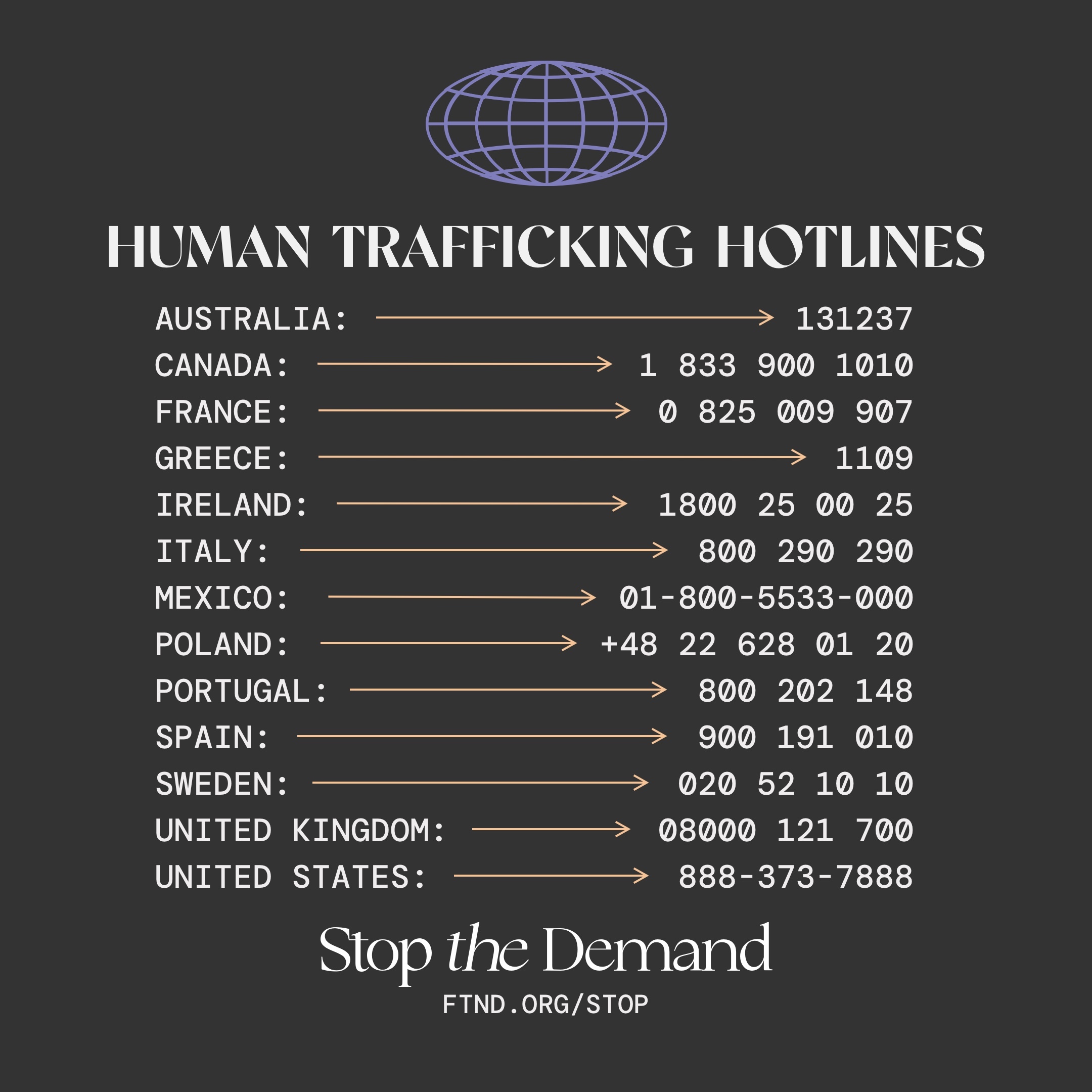Disclaimer: Fight the New Drug is a non-religious and non-legislative awareness and education organization. Some of the issues discussed in the following article are legislatively-affiliated. Including links and discussions about these legislative matters does not constitute an endorsement by Fight the New Drug. Though our organization is non-legislative, we fully support the regulation of already illegal forms of pornography and sexual exploitation, including the fight against sex trafficking.
Did you know sex trafficking is a global industry?
It operates like a market with supply, demand, and distribution. As an example, we experience these basic economic principles when we go to the grocery stores that distribute food, see the supply of fresh produce farmers grow, and we as customers drive demand for products based on what we buy.
Obviously, we aren’t talking about fruits and vegetables when we talk about sex trafficking. In this illicit market, traffickers are the distribution, demand is driven by sex buyers, and the victims are the supply.
Think about that for a moment. In human trafficking, people are the products for sale. Not only is this illegal, it is also unethical because people are not products that can be bought or sold.
Recently, we detailed and identified the people in the sex trafficking world: the victims, traffickers, and buyers. We examined who they are and their motivations. Now, we want to talk about solutions.
For a complex social issue, we need a multi-faceted solution that includes protection, prosecution, and prevention.
This means supporting victims, bringing justice to traffickers, holding buyers accountable, and rejecting aspects of our culture that normalize exploitation. This is easier said than done, but for the sake of victims, we owe them our awareness and efforts to work toward a world that has conquered human slavery.
Protection: The victims
Identifying and rescuing victims is a crucial step, and the faster this happens, the better it is for a victim both mentally and physically. Removing victims from trafficking situations becomes more complex once we realize that not all victims are physically restrained. This is a common myth of sex trafficking.
For years, the go-to strategy has been to remove victims in police raids. This method could be successful, but it often does not take into account the power dynamics between traffickers and victims. As we mentioned, not all victims are waiting to be physically freed. Psychological manipulation or financial restraints can keep them tethered to their trafficker.
For these reasons, many organizations and advocates have moved away from the idea of victim “rescue.” Simply removing them from the situation does not also rescue them from the trauma they have experienced.
Even after a raid, some victims return to their trafficker. To those of us who have never experienced sex trafficking, this may seem unbelievable. An organization that’s working to end child trafficking and exploitation, Thorn, explained it this way:
“It may take 6-7 attempts to exit the Life before a permanent exit occurs. This happens for the same reason it takes multiple exits for domestic violence victims—the emotional bond to the trafficker.”
When victims exit an exploitative situation, they need support, not a criminal record. This can include immediate shelter and basic necessities, mental health services, reintroducing practical daily life activities, and seeking employment. This last aspect can help survivors find the financial freedom they need to avoid re-trafficking.
Being sex trafficked is a “lifetime cost” meaning we owe survivors support and kindness well beyond their exit.
Prosecution: The traffickers
Bringing justice to traffickers is a difficult task. The first step is to identify and catch traffickers, which is the easier part. What is challenging is successfully moving them through the criminal justice system and convicting them of a sex trafficking charge.
Not only is it difficult to collect evidence to prove a case of sex trafficking beyond a reasonable doubt, but a conviction often requires the help of the victim. As you can imagine, there are similar “he said, she said” issues like in sexual assault cases; however, the victim’s testimony is still important to secure.
One study reported that the most frequent challenge law enforcement agencies faced to investigate sex trafficking cases was “lack of victim cooperation,” which is a harsh way of saying they are afraid to participate. Paradoxically, it is often this fear that alerts law enforcement to the case in the first place. Beyond fear, a victim may not want to participate because sex trafficking cases take a long time, even more time than other criminal cases like labor trafficking.
Related: Who Are Sex Traffickers, And Why Do They Exploit Other Humans?
As an example, the infamous GirlsDoPorn case where 22 women took porn producers to court for sex trafficking them has been ongoing for about 4 years. Many of the women were sex trafficked into performing in porn in 2015 and 2016, and while the civil suit was settled, the criminal case against the porn producers for federal sex trafficking charges has not happened yet.
If a victim does choose to participate, the defense will often try to undermine the victim’s testimony. Unfortunately, this can be done because the victim may have a criminal record as a result of being trafficked, or their memory may be questioned because of their past traumas. Combine all of these challenges together and it can be further traumatizing to victims and may not even result in a conviction.
The alternative is reverse sting operations. For example, a female police officer can pose undercover as a prostituted person on the street or online. She successfully attracts the attention of a “pimp” who begins to recruit her for trafficking purposes. In these operations, law enforcement have clearly documented evidence of trafficking and the police officer is able to give testimony in court.
The downside is that these operations require resources. They can make a dent, but there is little evidence that going after traffickers fights demand. Arrests and successful prosecutions bring justice and may benefit victims, but it will not solve trafficking on its own.
Which brings us to what drives the demand: buyers.
Prosecution and Prevention: The buyers
If we could wave a magic wand and remove all victims from exploitation and justly punish all traffickers, everyone would take that option. But even if we could, trafficking would still return because of the demand. While there are still buyers who want to purchase sex, there will be traffickers coercing victims.
Throughout history, holding buyers accountable has largely been left out of the sex trafficking solution. This ends now.
We know there isn’t one single profile of a sex buyer. The majority are men, but those men come from a variety of backgrounds and express different motivations. They do tend to be insensitive and more likely to justify sex buying by saying things like, they are “just guys being guys” or “taking care of their needs,” as opposed to non-buyers who are more likely to say that purchasing sex is exploitative and treats females as objects.
Clearly, buyers need better information, and there are programs that do just this. One example is a one-day education course for first time arrested sex buyers in San Francisco.
In 2008, researchers analyzed the effectiveness of the program by looking for a second arrest for sex buying in the ten years before the education program and ten years after. The researchers did not expect the course to create lasting effects because it is difficult to change a person’s behavior, but the results revealed the rearrest rate dropped by 40% after the education program began. It appears to be successful in changing buyer behaviors.
Addressing the demand includes changing our thinking. The old-school idea was that police should arrest sex workers to take them off the street, but this appears to do more harm than good. Focusing on demand requires a shift of resources to focus on the buyer.
Prevention: A cultural makeover
Prevention is often forgotten or ignored as part of the sex trafficking solution. Focusing on buyers is one side of the story, but we also need to consider our culture that normalizes sex buying and exploitation.
You may be thinking, hold on, no one is in favor of sex trafficking. How can this be “normalized” in our society?
According to Eli Zucker, the Director of Men’s Accountability at a Seattle anti-trafficking nonprofit, sex buying is tied up in buyers’ understanding of what it means to be a man. From interacting with male sex buyers as a facilitator for a re-education program, Zucker noticed the messaging around masculinity is holding them back. Some of those messages are that men should be overly sexual, dominant, and always ready for sex with lots of different women. Men learn early that they should be aggressive and unemotional.
“In this brand of masculinity, failure is inevitable. It is here, in this impossible but inevitable corner, that men often develop violent and unhealthy behaviors, like sex buying or using pornography, to meet the unachievable standards of this specific version of masculinity.”
Clearly these particular messages of how a man “should be” aren’t serving men and definitely not victims. Yet these messages are loud and clear in pornography.
The online porn world breeds a strong sense of sexual entitlement that normalizes sex buying behaviors. We see this when buyers say they believe sex buying is harmless fun and that the women are empowered in that industry. We hear similar excuses in the world of pornography, too.
Maybe we should be asking ourselves, why do some of our culture’s ideas of “fun” involve objectication?
Obviously, sex trafficking existed before internet pornography, so we can’t say it is the sole cause, but research continually shows that porn is directly connected to fueling the demand for sex trafficking.
Clicking, downloading, and consuming porn sends the message that our society accepts exploitation for “fun.” But we can counter that message with our actions. People aren’t products and bodies aren’t commodities, let’s not treat them that way.






